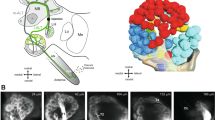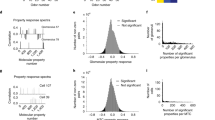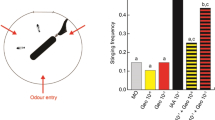Abstract
Odors are coded by glomerular activity patterns in the insect antennal lobe (AL) and in the mammalian olfactory bulb. We measured glomerular responses to 30 different odors in the AL of honeybees using calcium-sensitive dyes. By subsequently staining glomeruli and identifying individual glomerular outlines, we were able to compare the patterns between animals. Regardless of whether the odors were mixtures or pure substances, environmental odors or pheromones, their representations were highly conserved among individuals. Therefore, it may be possible to create a functional atlas of the AL in which particular molecular receptive ranges are attributed to each glomerulus.
This is a preview of subscription content, access via your institution
Access options
Subscribe to this journal
Receive 12 print issues and online access
$209.00 per year
only $17.42 per issue
Buy this article
- Purchase on Springer Link
- Instant access to full article PDF
Prices may be subject to local taxes which are calculated during checkout




Similar content being viewed by others
References
Steward, W. B., Kauer, J. S. & Shepherd, G. M. Functional organization of rat olfactory bulb analysed by the 2-deoxyglucose method. J. Comp. Neurol. 185, 715–734 (1979).
Cinelli, A. R., Hamilton, K. A. & Kauer, J. S. Salamander olfactory bulb neuronal activity observed by video rate, voltage-sensitive dye imaging. III. Spatial and temporal properties of responses evoked by odorant stimulation. J. Neurophysiol. 73, 2053–2071 (1995).
Johnson, B. A. & Leon, M. Spatial distribution of [14C]2-deoxyglucose uptake in the glomerular layer of the rat olfactory bulb following early odor preference learning. J. Comp Neurol. 376, 557–566 ( 1996).
Johnson, B. A., Woo, C. C. & Leon, M. Spatial coding of odorant features in the glomerular layer of the rat olfactory bulb. J. Comp. Neurol. 393, 457–471 (1998).
Friedrich, R. W. & Korsching, S. I. Combinatorial and chemotopic odorant coding in the zebrafish olfactory bulb visualized by optical imaging. Neuron 18, 737– 752 (1997).
Friedrich, R. W. & Korsching, S. I. Chemotopic, combinatorial, and noncombinatorial odorant representations in the olfactory bulb revealed using a voltage-sensitive axon tracer. J. Neurosci . 18, 9977–9988 ( 1998).
Rodrigues, V. Spatial coding of olfactory information in the antennal lobe of Drosophila melanogaster. Brain Res. 453, 299– 307 (1988).
Distler, P. G., Bausenwein, B. & Boeckh, J. Localization of odor-induced neuronal activity in the antennal lobes of the blowfly Calliphora vicina: a [3H] 2-deoxyglucose labeling study. Brain Res. 805, 263– 266 (1998).
Joerges, J., Kuettner, A., Galizia, C. G. & Menzel, R. Representations of odors and odor mixtures visualized in the honeybee brain. Nature 387, 285–288 (1997).
Galizia, C. G., Joerges, J., Kuettner, A., Faber, T. & Menzel, R. A semi-in-vivo preparation for optical recording of the insect brain. J. Neurosci. Methods 76, 61–69 (1997).
Galizia, C. G., Nägler, K., Hölldobler, B. & Menzel, R. Odor coding is bilaterally symmetrical in the antennal lobes of honeybees (Apis mellifera). Eur. J. Neurosci. 10, 2964–2974 (1998).
Faber, T., Joerges, J. & Menzel, R. Associative learning modifies neural representations of odors in the insect brain. Nat. Neurosci. 2, 74–78 (1999).
Mombaerts, P. et al. Visualizing an olfactory sensory map. Cell 87, 675–686 (1996).
Shepherd, G. M. Discrimination of molecular signals by the olfactory receptor neuron. Neuron 13, 771–790 ( 1994).
Mori, K., Mataga, N. & Imamura, K. Differential specificities of single mitral cells in rabbit olfactory bulb for a homologous series of fatty acid odor molecules. J. Neurophysiol. 67, 786– 789 (1992).
Teicher, M. H., Stewart, W. B., Kauer, J. S. & Shepherd, G. M. Suckling pheromone stimulation of a modified glomerular region in the developing rat olfactory bulb revealed by the 2-deoxyglucose method. Brain Res. 194, 530–535 ( 1980).
Hildebrand, J. G. Olfactory control of behavior in moths: Central processing of odor information and the functional significance of olfactory glomeruli. J. Comp. Physiol. A 178, 5–19 ( 1996).
Rospars, J. P. Structure and development of the insect antennodeutocerebral system. Int. J. Insect Morphol. Embryol. 17, 243– 294 (1988).
Flanagan, D. & Mercer, A. R. An atlas and 3-D reconstruction of the antennal lobes in the worker honey bee, Apis mellifera L. (Hymenoptera: Apidae). Int. J. Insect Morphol. Embryol. 18, 145–159 (1989).
Galizia, C. G., McIlwrath, S. L. & Menzel, R. A digital three-dimensional atlas of the honeybee antennal lobe based on optical sections acquired using confocal microscopy. Cell Tissue Res. 295, 383–394 (1999).
Stopfer, M., Bhagavan, S., Smith, B. H. & Laurent, G. Impaired odor discrimination on desynchronization of odor-encoding neural assemblies. Nature 390, 70– 74 (1997).
Kramer, E. The orientation of walking honeybees in odor fields with small concentration gradients. Physiol. Entomol. 27–37 (1976).
Bhagavan, S. & Smith, B. H. Olfactory conditioning in the honey bee, Apis mellifera: Effects of odor intensity. Physiol. Behav. 61, 107–117 ( 1997).
Slotnick, B. M., Graham, S., Laing, D. G. & Bell, G. A. Odor detection in rats with lesions of areas identified using the 2-deoxyglucose method. Ann. NY Acad. Sci. 510, 630– 631 (1987).
Lu, X.-C. M. & Slotnick, B. M. Olfaction in rats with extensive lesions of the olfactory bulbs: implications for odor coding. Neuroscience 984, 849–866 (1998).
Sigg, D., Thompson, C. M. & Mercer, A. R. Activity-dependent changes to the brain and behavior of the honey bee, Apis mellifera (L.). J. Neurosci. 17, 7148–7156 (1997).
Winnington, A. P., Napper, R. M. & Mercer, A. R. Structural plasticity of identified glomeruli in the antennal lobes of the adult worker honey bee. J. Comp. Neurol. 365, 479–490 ( 1996).
Burrows, M. The Neurobiology of an Insect Brain. (Oxford Univ. Press, Oxford, 1996).
Yokoi, M., Mori, K. & Nakanishi, S. Refinement of odor molecule tuning by dendrodendritic synaptic inhibition in the olfactory bulb. Proc. Natl. Acad. Sci. USA 92, 3371–3375 ( 1995).
Acknowledgements
Thanks to J. Kunze and A. Gumbert for the odors HYA and NAR. Thanks to T. Faber, M. Wurm for comments on an earlier version of the manuscript. Supported by DFG Me 365-21.
Author information
Authors and Affiliations
Corresponding author
Rights and permissions
About this article
Cite this article
Galizia, C., Sachse, S., Rappert, A. et al. The glomerular code for odor representation is species specific in the honeybee Apis mellifera. Nat Neurosci 2, 473–478 (1999). https://doi.org/10.1038/8144
Accepted:
Issue Date:
DOI: https://doi.org/10.1038/8144
This article is cited by
-
All-optical manipulation of the Drosophila olfactory system
Scientific Reports (2022)
-
Antenna movements as a function of odorants’ biological value in honeybees (Apis mellifera L.)
Scientific Reports (2022)
-
The involvement of a floral scent in plant-honeybee interaction
The Science of Nature (2022)
-
The neuroethology of olfactory sex communication in the honeybee Apis mellifera L.
Cell and Tissue Research (2021)
-
Olfactory coding in honeybees
Cell and Tissue Research (2021)



